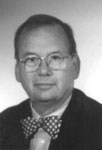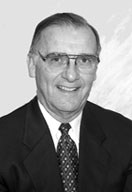
Chemistry International
Vol. 22, No.4, July 2000
2000, Vol. 22
No. 4 (July)
..Chemistry in Argentina
..News from IUPAC
..Report of Accounts 1998-99
..Reports from Symposia
..Reports from Commissions
..Provisional Recommendations
..Awards and Prizes
..New Books
..Conference Announcements
..Conference Calendar
Download the July
issue in pdf format.
(544K)
Chemistry International
Vol. 22, No. 4
July 2000Report on IUPAC's Financial Condition for the Biennium 1998—1999
Introduction
Near-Term Operational Income and Expense
Long-Term Investments
Total IUPAC Portfolio GrowthAuditor's Report and Balance Sheets
After serving IUPAC as Treasurer and Chairman of the Finance Committee for eight years, Prof. John Ward has taken a well-deserved retirement from the financial helm of IUPAC. During his term, IUPAC’s financial condition improved from a position of income not meeting expenses in the biennium to a position during the 1998—1999 biennium in which income covered expenses and long-term reserves have been established to strong levels.
Financial responsibilities have transferred to Dr. Christoph Buxtorf, newly elected Treasurer of IUPAC and recently retired Head of Production and Technology of Novartis Crop Protection (Switzerland), and Dr. Edwin Przybylowicz, Chairman of the Finance Committee and retired Director of Research at Eastman Kodak Co. (USA). This report on the financial condition of IUPAC is submitted to the IUPAC membership as a summary. These comments are based on the financial figures summarized in the tables that are part of this report. More detailed financial statements can be found on the IUPAC web site. The comments are summarized in two categories: near-term operational income/expense and long-term investments.
Near-Term Operational Income and Expense
Over the past biennium, IUPAC income has exceeded expenses by USD 373 500, an amount that was significantly greater than in the previous biennium (1996-1997) when income exceeded expenses by USD 20 600. Much of the surplus from these years has been moved to our long-term investment accounts, where it has been earning a good return for potential use to support the organization’s projects.
The surplus during the past biennium is the result of a number of factors, including: (1) a more efficient operation of the Secretariat at Research Triangle Park, (2) stronger fiscal management of expenses by Divisions and Standing Committees, and (3) tight fiscal management by our Treasurer. The impending reorganization of the work done by IUPAC may have also caused some reduction in spending during this millennium. As the new project system gets established, it is anticipated that expenses and income will be more closely matched. There are some cautions and concerns to be noted, however, as we view IUPAC’s operational financial condition. On the income side, our national subscriptions provide slightly over 50% of our operating income. This income represents the main support of our organization; however, it is subject to monetary fluctuations and regional macroeconomic problems that regularly impact the organization. For example, countries where severe inflation has caused hardships are not able to meet their annual subscription because inflation has diminished the value of their currencies. Such circumstances are recognized and handled on a temporary basis by the Officers of the Union in a way that does not impact the participation of the countries in IUPAC activities. However, such occurrences do impact IUPAC’s budgeted income levels. This effect has occurred in the recent past, and IUPAC’s financial plans must take the possibility of such events into account.
Another major contributor to our biennial income is IUPAC publications. During the past biennium, publication income provided approximately 33% of the total income. IUPAC, under the leadership of our Executive Director, Dr. John Jost, has moved in the direction of self-publishing. This change has improved the response time for IUPAC publications and has also resulted in a significant improvement in income. One caution in the longer term is whether printed publications will continue to provide such income levels, given the trend toward electronic publication and use of the excellent IUPAC web site.
The third major contributor to IUPAC income derives from dividends and interest. During the past biennium, these sources have contributed 9%, down slightly from the 10% of the previous biennium. This item is mainly determined by the Union’s average cash position and the prevailing interest rates. On the expense side, total expenses for this biennium are down by 8% over the previous biennium, during which the Secretariat was moved from Oxford, England to Research Triangle Park, North Carolina (USA). While this move had a significant impact on our operations, it did not impact the scientific work of the organization. Prof. Ward regularly reminded the Division Presidents and Standing Committee Chairs of the availability of funding for worthy projects.
It will be a challenging task to select and support projects under the Strategic Plan 2000—2001. IUPAC will undergo a fundamental strategic change in the years ahead, from a commission-based to a project-driven "new millennium" organization. The challenge for financial planning will be to provide the necessary support for good projects as well as an equitable distribution of funds across the broad spectrum of activities in which IUPAC is involved.
Long-term investments for IUPAC are subdivided into four funds: (1) Reserve Fund, (2) Southern Hemisphere Sinking Fund, (3) Endowment Fund, and (4) Endowment Fund Reserve. While the accounting practice shows specific amounts of money allocated to each of these funds, for investment purposes, the aggregate of the four funds is handled as a single portfolio. The purpose of each of these funds is as follows:
Reserve Fund
This fund is intended to provide operational expenses to carry IUPAC for a full biennium, should other sources of income not be forthcoming. It is the prime financial protection for the Union in the event of a severe worldwide economic downturn.
Southern Hemisphere Sinking Fund
This fund is one that is planned to be used to help hold General Assembly and Congress meetings in places where the costs of travel, meeting arrangements, etc. are considerably more expensive than the norm. It is anticipated that significant use of this fund will be made during the upcoming General Assembly and Congress in Brisbane, Australia.
Endowment Fund
This fund was established to pay for special projects of a broad nature that enhance the stature of the Union. For example, the recently established IUPAC Prize for Young Chemists will be supported entirely by the proceeds from the Endowment Fund. Proceeds from this fund are calculated using the yield on fixed income investments rather than the entire portfolio.
Endowment Fund Reserve
This fund was created to provide matching funds from IUPAC to add to outside funds that might be made available to IUPAC for endowment purposes. The Endowment Fund Reserve would match funding for projects of an ongoing nature from partnerships of IUPAC with industry, government, or technical organizations.
The total IUPAC investment portfolio grew from a value of USD 3 055 920 at the end of the previous biennium (market value as of 31 December 1997) to USD 3 940 707 (market value as of 31 December 1999) for a 29% gain in value. This change is the result of two factors: (1) the investment growth of the portfolio during this period, and (2) savings that were accrued from operations during this period and transferred to the long-term investment account.
During the past biennium, the Finance Committee and Treasurer have established a balanced portfolio of 60% equities and 40% fixed income investments, with a regional balance of 60% U.S. investments and 40% in Europe. During the next year, the Finance Committee will develop a written investment policy statement, which will be reviewed and approved regularly by Officers of the Union, as a means of understanding and maintaining IUPAC’s strong financial condition.
>Download Auditor's Report and Balance Sheets [pdf file - 35K]
News
and Notices - Organizations and People
- Standing Committees
Divisions
- Projects - Reports
- Publications - Symposia
- AMP - Links
Page last modified 23 June 2000.
Copyright © 1997-2000 International Union of Pure and Applied Chemistry.
Questions or comments about IUPAC, please
contact the Secretariat.
Questions regarding the website, please contact [email protected]


